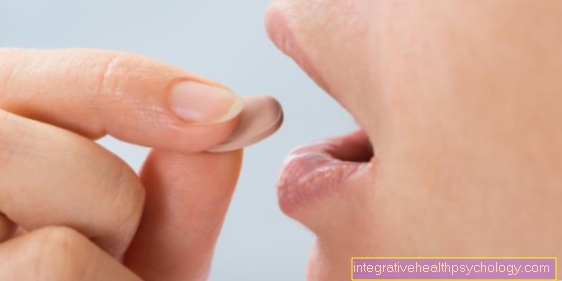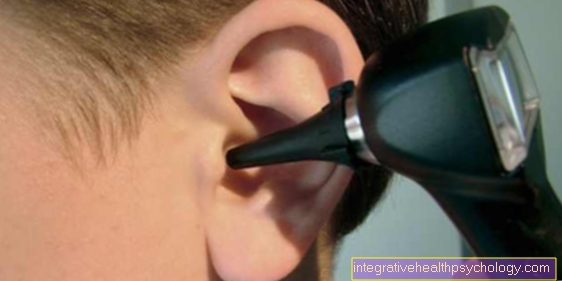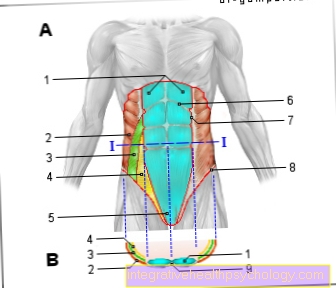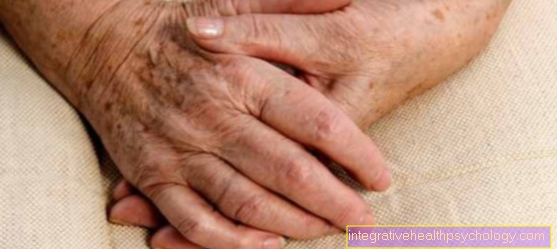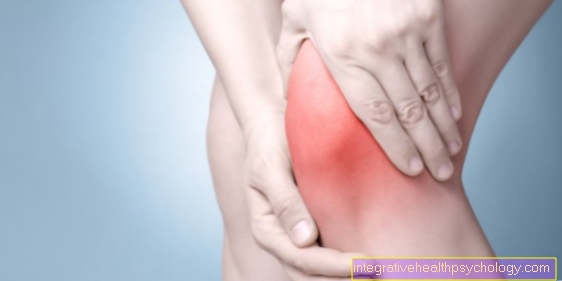Urethral stricture
Synonyms
Urethral narrowing, urethral stricture
definition
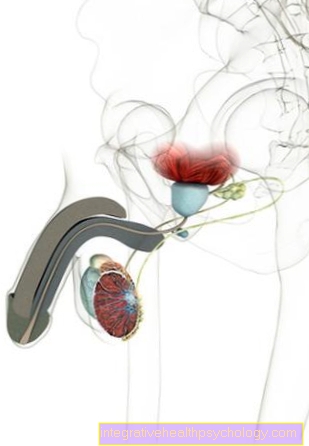
The urethral stricture is a pathological narrowing of the urethra. Basically, a innate and one acquired Differentiated narrowing. Due to anatomical factors, men are far more likely to suffer from urethral strictures than women
Congenital causes
Malformations on the external genitalia are often the cause of a congenital urethral stricture. For example, the urethra itself can develop a developmental disorder. This is called in medicine Hypospadias designated. The mouth of the urethra is further forward and closer to the body. Often a penile curvature and a split in the foreskin occur at the same time. Through the relocated mouth of the urethra, the micturition (Urination) difficult, as the urine stream tends towards the back and down.
Acquired causes
The most common causes of urethral strictures are those that after an injury occur. Even the smallest ones play Microtraumas a major role. These minimal injuries can occur, for example, during catheterization. Laying one Urinary catheter can cause minor injuries to the urethra. These small tears can heal with scarsso that the scar tissue grows into the lumen of the urethra. Similar injuries also occur during endoscopic interventions like the Cystoscopy. The so-called Straddle trauma is another possibility to get a urethral constriction. These are blunt and direct traumas in the area of the perineum. Among other things, they can arise when cycling. Injuries to the urethra and bladder can also occur in the context of a traffic accident. At Pelvic bone fractures can vary depending on the severity of the injury Complete tear off of the urethra or bladder as well as prostate arise. The more severe the injury, the bigger the subsequent scar. In some cases even then a complete closure of the urethra occur.
If a urethral constriction is suspected, various diseases should be considered in the diagnosis and therefore examined more closely. These include benign enlargement of the prostate, tumors near the urethra and bladder, and prostate cancer. Depending on the location and size of the surrounding tumors, these can narrow the urethra and disrupt urination. Furthermore, infections like a Urethritis or infectious diseases, like Gonorrhea, affect the function of the urethra by causing inflammation and damage to the mucous membrane.
Symptoms
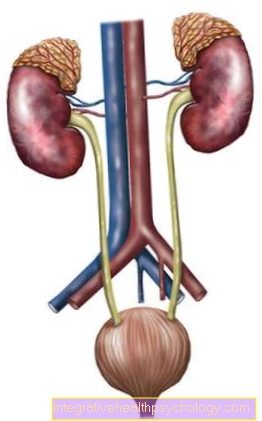
The first symptoms often appear years after the acquired urethral injury. The first sign and that too Main symptom is a clear one Weakening of the urine stream. This can vary in strength. The urine stream itself may be twisted or even split, indicating an obstruction in the urethra.
Over time, the attenuation may increase in severity until it eventually becomes one Urinary retentiont comes. The patient is then no longer able to empty his bladder, which is usually completely full. In many cases, severe pain occurs in the lower abdomen.The urine then not only builds up in the urinary bladder, but in extreme cases can also build up into a backlog Renal pelvis develop. The function of the kidneys is significantly impaired as a result and kidney failure can occur. This represents a life threatening situation and should be treated immediately.
Continuous urination against resistance leads to thickening and over time Enlargement of the bladder muscle (Bladder hypertrophy). As a result, the elasticity of the urinary bladder decreases and the emptying function deteriorates. Most patients also report difficulty urinating, which requires more effort. At the same time, they only empty a little urine and have to go to the toilet more often than normal. They often feel an urge to urinate because they always have one Residual urine keep in the bladder.
If there are infections or inflammations, this can be detected in the urine blood. This is known as Microhematuria and can be detected by means of a rapid test. If a urethral stricture is ignored and left untreated, it can ultimately lead to uncontrolled loss of urine, known as urinary incontinence.
Diagnosis
The diagnosis of a urethral stricture includes the Urinary stream measurement. This is also called the Uroflowmetry designated. The patient's urine stream is measured in a special toilet. A curve is created automatically. The bladder is then displayed using an ultrasound device and the doctor can see whether there is still any residual urine in the bladder. Based on the measurements and the amount of residual urine, the urologist can determine whether there is a significant narrowing of the urethra. Then the location and extent of the constriction in the urethra is determined. This is done with the help of an X-ray or by a Cystoscopy.
therapy
Treatment of a urethral stricture can vary greatly as there are different methods that are used in different cases. Which treatment option is the best depends on a few factors such as Location and length of the bottleneck such as Age and secondary illnesses of the patient dependent. If possible, the wishes of the patient should also be taken into account.
Urethral dilatation
As Bougienage called method is a simple method of expanding the lumen of the urethra. With special Urethral catheters, which come in different sizes, will be the Enlargement of the urethra (Dilation) performed. The treatment can be carried out by a urologist or as directed by the patient himself. The application can reduce the symptoms for a certain time, but after a while the method has to be used repeated regularly become and it also becomes less effective over time. In addition, the bougienage contains that risk, that the Urethra will continue to be injuredwhich can make the narrowing worse. Depending on the condition and severity of the bottleneck, however, this measure can be very helpful.
Urethral slit (urethrotomy)
In this treatment method, the urethral constriction is slit in a targeted manner so that the Scar split in a controlled manner becomes. The procedure is especially for short bottlenecks suitable and promises an improvement. It is usually performed under a brief anesthetic. The cleavage can also be carried out with the help of a laser instead of a knife. Lasering is a gentle and promising approach. In the Slitting to Sachse the constriction is incised into the healthy tissue under vision to prevent a renewed scar contracture. In the Slot according to Otis the urethra is first stretched to the appropriate and desired width with the help of a urethrotome. A blade is then drawn through the urethrotome, cutting the urethra at 12 o'clock. The Otis method is used for long structures and is more likely to be used in the context of palliative treatment of urethral strictures.
Urethral stent
Another possibility is the insertion of a stent. This is a expandable, small tube made of metal or plastic that is inserted into the urethra around the to keep the narrowed point open. This method also has a disadvantage. The scar and lining of the urethra may repeatedly react to the stent with excess scar tissue growth or inflammation. In many cases the stent has to be removed again. Therefore, the insertion of a tube is only made under certain circumstances in the urethral stricture.
surgery
In most cases one promises Urethral surgery or Urethral reconstruction during an operation die best successes and Long term results if you have a urethral stricture. In the operating room, the urethra is opened and the constriction is removed. Then you can put the ends of the rest of the urethra in one End-to-end anastomosis are sewn together again. If the bottleneck was very long and therefore a longer distance has to be bridged, a Urethral replacement used. In the best case, this is the patient's own body tissue. This significantly prevents the occurrence of repeated inflammatory reactions. The foreskin or free oral mucosa is used to insert the transplant. The operation is complex and technically demanding, which is why it can take up to four hours. A urinary catheter then remains in the new urethra for about one to three weeks so that the sutures can heal and there is no infection.
A urethral stricture in women
Women suffer from a urethral stricture much less often, since the urethra is anatomically significantly shorter than in men. For this reason alone, true strictures are not common in women. However, both congenital and acquired constrictions can occur. The malformation hypospadias manifests itself in women as a displacement of the urethra into the vaginal wall. This causes the urine to drain through the vagina. Due to the anatomical conditions, the woman's urethra is much more susceptible to infection due to invading bacteria. Infections and catheterization can lead to injuries and scars in the mucous membrane of the urethra in women as well. This can also lead to constrictions that affect urination.



.jpg)

